مقدمة
مقتبس من: HARVEY (2007)
تشمل المرحلة الأولى للطوارئ التدخلات المباشرة وتستمر عادة من شهر إلى ثلاثة أشهر. فهي تهدف إلى توفير المرافق الأساسية لاحتواء وفصل الفضلات، ولمنع انتقال الامراض المنقولة عن طريق البراز والفم و التلوث من مصادر المياه (انظر أيضًا الصرف الصحي في حالات الطوارئ). المواقف في حالة الطوارئ لا تتقدم بشكل منتظم ومستمر: في بعض المواقف قد يتطور الأمر إلى وضع أكثر حدة بعد تنفيذ التحسينات، على سبيل المثال، عند زيادة أعداد المتضررين، أو عند حدوث وباء، أو تدهور في الحالة الأمنية.
الأولوية في المرحلة الطارئه هي سرعة تثبيت التقنيات لاحتواء الفضلات. يعتبر نظام النقل، والموارد المتاحة على أرض الواقع، واحتمالية حدوث كارثة مستمرة تحديات صعبة (HARVEY 2007).
يتم تنفيذ تدخلات فورية بسرعة مصممة للاستخدام على المدى القصير. بما أن الخيارات قد تكون محدودة من جهة القبول والاستدامة الاجتماعية والاقتصادية، فينبغي استشارة أعضاء المجتمع المتضررين فيما يتعلق بالتوزيع ونوع المرافق. ومع ذلك فمن المهم اعتبار خيارات التخلص المستقبلية المرجحة في هذه المرحلة لضمان عدم وجود آثار ضارة لها على الصرف الصحي في حالات الطوارئ المتوسطة أو طويلة الأمد (HARVEY 2007).
الاولويات | احتواء الفضلات في أسرع وقت ممكن |
مشاركة المعنيين | مستوى المجتمع، أو الحي، أو المخيم |
التخطيط واختيار التقنيات | إصلاح المرافق الحالية
كثافة السكان المستهدفين (النازحين): السيطرة على التغوط العشوائي (التغوط في العراء المتحكم به)؛ المراحيض في الخنادق الضحلة والعميقة
السكان المستهدفين المبعثرين (النازحين أو "في الموقع"): الالتفاف، والاحتواء، والجمع
في كلتا الحالتين: الحفر مراحيض; borehole latrines; بيبو كيس; simple urine diverting toilets; اربولو; raised latrines / floating toilets |
خيارات للمرحلة العاجلة في حالات الطوارئ
في حين يمكن تعريف مراحل طوارئ معينة، فإن اختيار نظام الصرف الصحي الفعلي لكل مرحلة يعتمد على حالة معينة، على سبيل المثال في حالة انتشار الناس في المناطق الحضرية، والاحتياجات الفعلية المتعلقة بخدمات الصرف الصحي. وقد تم استخدام الخيارات التالية في الماضي خلال الاستجابة الفورية لحالات الطوارئ، واتبعت معظم الخيارات طريقة التخلص من الفضلات في الموقع من دون علاج.
يمكن استخدام أنظمة التخلص من الفضلات في الموقع في معظم حالات الطوارئ حيث يتم التخلص من النفايات البشرية من دون معالجة. وتشمل هذه المرافق حقول التغوط المفتوحة، أو المراحيض الخندقية، أو مراحيض البئر، أو مراحيض الحفر. توجد خيارات أخرى عندما يتعذر التصريف والرشح فى طبقات التربة ، على سبيل المثال، في البيئات الحضرية، ارتفاع منسوب المياه، التضاريس الصخرية التي لا تسمح بالحفر، أو حيث يعتبر منع تلوث المياه الجوفية أمرًا بالغ الأهمية (HARVEYوآخرون. 2002; HARVEY 2007). تجعل بعض هذه القيود والأسباب أخرى ( وقت ملء المرحاض) مراحيض تصريف البول أو خيارات أخرى مثل arborloo تعد الأفضل، حتى في المرحلة العاجلة في حالات الطوارئ (OXFAM 2009؛ RUBERTOو JOHANNESSEN 2009).
كثافة السكان المستهدفين (النازحين): الادارة والسيطرة على التغوط في العراء والمراحيض الخندقية
في حالات النزوح ووجود عدد كبير من الناس، يمكن فان السيطرة على التغوط في العراء هو الحل المدقع على المدى القصير عندما تكون المساحة غير كافية. يجب تجنب تلوث المياه الجوفية بأي وسيلة عن طريق اختيار الموقع المناسب. وينبغي تنظيم مرافق غسل اليدين والمراقبة كما يجب تغطية جميع الفضلات بالتراب في أقرب وقت ممكنHARVEY 2007). في الواقع، لا يبدو أن هذا الأسلوب يتم تنفيذه على نطاق واسع جدًا(JOHANNESSEN & BIKABA 2009).
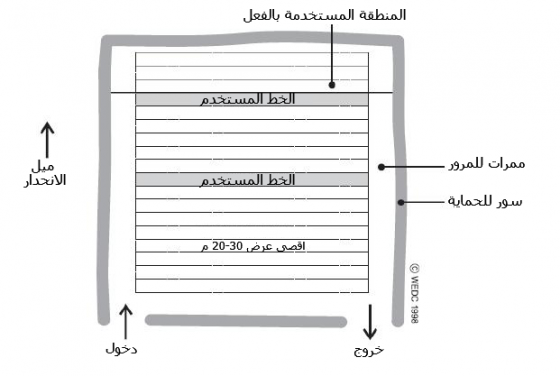
وضع حقل تغوط في العراء: يحتاج المستخدمون إلى استخدام القطاع الأبعد بعيدًا عن المدخل، وتغطية الفضلات الخاصة بهم بالتراب وغسل اليدين بعد ذلك. المصدر: HARVEY وآخرون 2002.
متى أمكن، تعتبر المراحيض الخندقية تحسينًا بسيطًا لحقل التغوط في العراء، ويبدو أنه يتم استخدامه بشكل أكثر في حالات الطوارئ(JOHANNESSEN & BIKABA 2009). وتسمح المراحيض الخندقية للمستخدمين بتغطية البراز، وتحسين الجوانب الصحية والراحة بصورة عامة عن نظام التغوط المفتوح. المكان الذي يتكاثر فيه الذباب (ناقل محتمل للأمراض التي تحدث بسبب الجراثيم) يعد سببُا للمشكلات، وبالتالي يتم استخدام معدة لمكافحة ناقلات الجراثيم(انظرOXFAM 2000). يجب أن تكون أبعاد خنادق الصرف الصحي بمقاس 20 - 30 سم عرض و15 سم عمق وذلك للمراحيض الخندقية غير العميقة، أو بعمق 2 متر للمراحيض الخندقية العميقة. يجب أن تكون على مسافة 15-30 م من أي مصدر للمياه الجوفية وأن يكون قاع أي مرحاض 1.5 م على الأقل فوق منسوب المياه الجوفية. يجب ردم المراحيض بالكامل بعمق 0.2 م من البلاطة(HARVEY 2007; JOHANNESSEN & BIKABA 2009)
نظرًا لأن المراحيض الخندقية العميقة تحتاج إلى تبطين، فيتم عادةً تدعيم البنية الفوقية للمرحاض منها بالخشب، أو بمرحاض الدفق بالصب (أنظمة المراحيض المبللة، وذلك في حالة توفر المياه). المراحيض الخندقيةي يمكن تأسيسها لاستيعاب عدة أشخاص، أو للعائلات انظر HARVEY et al. 2002
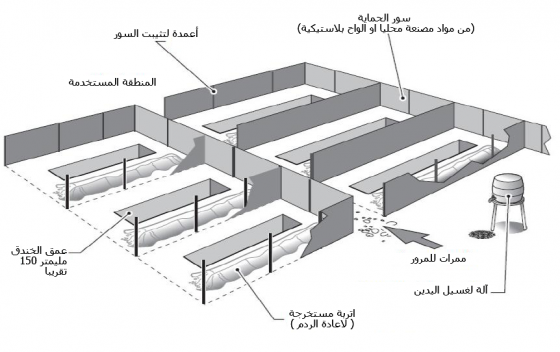
مخطط لحقل مراحيض خندقية غير عميقة. المصدر: HARVEY et al. 2002.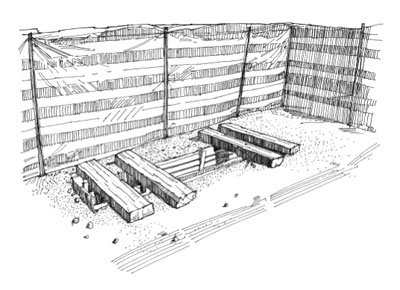
خندق مرحاض بسيط جدًا ذو حفرة مثبتة وأغطية فوقية. المصدر: SHAW 2010.
وتشمل بعض الخيارات الأخرى للمرحلة الفورية لحالات الطوارئ استخدام الدلو كمرحاض أو حاويات مراحيض او خزان كبير (بلاستيك) لتخزين متحتويات مجموعة من المراحيض أو مراحيض كيميائية(HARVEY et al. 2002; HARVEY 2007).
السكان المستهدفين في الموقع: الالتفاف، والاحتواء، والجمع
وبالنسبة لحالات "في الموقع"، فقد يكون إصلاح المراحيض الموجودة الخيار الأفضل. أثناء الفيضانات، قد لا يمكن إصلاح المراحيض المنزلية ولمنع زيادة التلوث من الفيضانات والمياه الجوفية، يمكن استخدام تقنية "الالتفاف، والاحتواء، والجمع". يتم تخزين وجمع الفضلات في دلاء أو حقائب(على سبيل المثال من خلال "قارب الصرف الصحي") وتقديمها إلى موقع المعالجة(PEN 2010).
تم تطبيق تقنية "الالتفاف والاحتواء والجمع" في فيضانات الفلبين، من قبل "منظمة أطباء بلا حدود"، وذلك باستخدام الدلاء البلاستيكية العادية (الخضراء ذات الغطاء الأصفر) التي تم جمعها بانتظام من قبل فريق الصرف الصحي على القارب. يمكن جمعها باستخدام وتوزيع حقائبpeepoo. المصدر: PEN 2010.
المزيد من حلول الصرف الصحي للاستجابة العاجلة في حالات الطوارئ
المراحيض
مرحاض الحفرة بدون استخدام نظام صب تعد التقنيات الأكثر شيوعًا المستخدم في حالات الطوارئ. وذلك لأنها بسيطة وسريعة في البناء كما أنها غير مكلفة عمومًا. لكنها تكون غير مناسبة عندما يكون منسوب المياه مرتفعًا وأو تكون التربة غير مستقرة للغاية أو صخرية جدًا.
تبعا للحالة، يمكن أن تكون الإجراءات فورية هي بناء مراحيض مشتركة او عائلية ضحلة أو عتمادًا على المساحة والمدة المتاحة (الإشراف). ينبغي أن تؤخذ الخبرة في بناء المراحيض والقبول لدى الناس في الحسبان كلما أمكن ذلك. بالرغم من أن المراحيض الخندقية تزيد من خصوصية العائلة مقارنة بالمراحيض الجماعية إلا أنها يصعب إدارتها. يبلغ عمق جميع الحفر الضحلة 0.3m x 0.5م و 1م عمقاً، لكن الحجم يعتمد على عدد المستخدمين. يجب إحكام غلق قمة جميع الحفر بأمان.
تستطيع البنى الفوقية البلاستيكية المموجة والمجهزة لحفر المراحيض المستخدمة من قبل الاتحاد الدولي لجمعيات الصليب الأحمر والهلال الأحمر في استجابة لزلزال هايتي عام 2010 أن تضمن الكرامة والخصوصية. بدلاً من ذلك يمكن صناعتها من مواد متوفرة محليًا لكنها عادة ما تستغرق وقتًا أطول. المصدر: الاتحاد الدولي لجمعيات الصليب الأحمر والهلال الأحمر 2011
تم تطوير البلاطات متعددة الوظائف لمراحيض الحفر من قبل منظمات الطوارئ. وقد صممت بشكل أفضل لكي تستخدم كبلاطات لفصل وتحويل البول . فهي تسمح بالفصل الفوري للبول مما يطيل من عمر مراحيض الحفر أو الخنادق(JOHANNESSEN 2011). عندما نعتبر تطوير المرافق الصحية في حالات الطوارئ في مراحل لاحقة، فإنه يمكن اعتبار المزيد من استخدام [مراحيض فصل وتحويل البول-1378] (انظر الصرف الصحي في حالات الطوارئ متوسطة المدى). عندما تستخدم الحفر لوقت أطول (والذي يعتبر في معظم الأحيان حالة)، فينبغي أخذ تفريغ الحفر في الاعتبار(HARVEY وآخرون. 2002؛JOHANNESSEN 2011) ؛ انظر أيضًاالنقل بالمجهود البشرى والنقل والتفريغ بواسطة المحركات والخيارات المختلفة لمعالجة مياه المجاري: نطاق صغير و تصنيع سماد واسع النطاق، الهضم اللاهوائي، احواض التجفيف، أحواض الترسيب، أو صغير و الحرق على نطاق واسع.
تعتبر مراحيض الآبار بديلًا حين تسمح لها ظروف الأرض أوتتوفر لها الأدوات والعمالة الفورية على المستوى المحلي
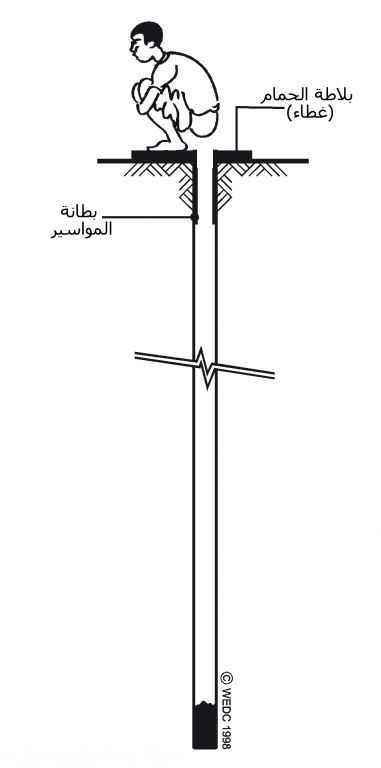
يقترح وضع مراحيض البئر كبديل لمراحيض الحفر في حالات الطوارئ عندما تسمح الظروف بذلك ولا يمكن حفر الحفر. المصدر: HARVEY 2007
حقيبة بيبو(Peepoo)
في حالات الطوارئ ينصح باستخدام أكياس بلاستيكية عادية أو اكياس بيبو في التدخل الفوري على مستوى الأسرة فورًا حتى يمكن بناء مراحيض مجتمعية أو مناسبة، عندما تتعرض المستوطنات فضاء مزمن أو قيود على استخدام الأراضي ، حيث يكون من الصعب عدم الاجتثاث، أو حيث تفضل مجموعات معينة (الضعيفة) التبرز في الملاجئ الشخصية. تساهم كلًا من الحقائب البلاستكية أو القابلة للتحلل البيولوجى في الحد من التغوط في العراء و"المراحيض الطائرة" في كارثة حضرية(PATEL وآخرون. 2011).
تعتبر اكياس بيبو مرحاض شخصي فردي الاستخدام يقوم بتعقيم فضلات الإنسان بعد التغوط بوقت قصير. كل هذا يتم من خلال حقيبة بلاستيكية حيوية قابلة للتحلل مغلفة باليوريا. فهي لا تحتاج إلى مياه غير المطلوبة لغسيل اليدين مما يكسر الرابط التقليدي بين المياه والصرف الصحي. وقد أثبتت فائدتها خلال الفترة التى تستغرق لبناء المراحيض الأخرى، وأثناء الفيضانات وللاستخدام الليلي، وخاصة من قبل النساء(VON MUENCH et al. 2009).
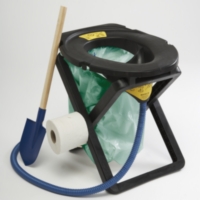
يستخدم مرحاض فصل وتحويل البول في حالة الطوارئ حقائب بلاستيكية قابلة للتحلل ويزن 4 كجم. تكون معالجة البول أسهل من خلال التصريف. تتوافر في الأسواق العديد من الحلول المشابهة ل " الذذى يفضلون الجلوس" ( بعكس الذين يفضلون وضع القرفصاء المصدر: SEPARETT 2011
المراحيض المرفوعة أو المرتفعة
المراحيض المرفوعة (أيضًا: المراحيض المرفوعة) مفيدة عندما يكون مستوى المياه الجوفية مرتفعًا، وعندما لا يمكن الحفر في التربة أو عندما يحظر امتلاك الأراضي. يمكن أن تستخدم المراحيض المغطاه بالمياه أو المراحيض الموجودة على أرض مرتفعة كبدائل(JOHANNESSEN وBIKABA 2009). تشتمل تحديات المراحيض المرتفعة على التركيب المكلف والبطئ والحاجة إلى الإزالة المتكررة(انظرالنقل بالمجهود البشرى والنقل والتفريغ بالمحركات) (انظر أيضًاOXFAM 2009). يمنع فصل وتحويل البول غرف جمع الفضلات من الامتلاء بسرعة (انظر أيضًا مراحيض فصل وتحويل البول و محتويات تصريف البول).
معدات المراحيض المرفوعة المزودة بخزان حاويات كما شيده الاتحاد الدولي لجمعيات الصليب الأحمر والهلال الأحمر في استجابة لزلزال هايتي عام 2010. الاتحاد الدولي لجمعيات الصليب الأحمر والهلال الأحمر 2011.
على الرغم من الحاجة إلى بعض الوقت لأجل التشييد، يمكن تطبيق مفهوم الرفع على بالتصميم العائم ؛ على سبيل المثال عندما تكون الأرض اليابسة لأجل البناء نادرة. وفي الفلبين تم تعزيز النسخة العائمة مع غرف الهضم حيث يحدث التحلل اللاهوائي (مراحيض الصرف الصحي العائمة). ثم تذهب النفايات السائلة إلى غرفة المعالجة، الأمر الذي يزيد من تحسين نوعية مياه الصرف إلى مستويات مقبولة(NORTHERN WATCH 2009)
مرحاض الصرف الصحي العائم كما هو مقدم في بوليناو بالفلبين. المصدر: PEN 2010.
Emergency Sanitation: Assessment and Programme Design
This book has been written to help all those involved in planning and implementing emergency sanitation programmes. The main focus is a systematic and structured approach to assessment and programme design. There is a strong emphasis on socio-cultural issues and community participation throughout.Includes an extensive “guidelines” section with rapid assessment instructions and details on programme design, planning and implementation.
HARVEY, P. BAGHRI, S. REED, B. (2002): Emergency Sanitation: Assessment and Programme Design. Loughborough: Water, Engineering and Development Centre (WEDC) URL [Accessed: 31.05.2019]Excreta Disposal in Emergencies. A Field Manual
In this manual existing, innovative and new technologies and approaches for excreta disposal in emergency situations are investigated. It provides practical guidance on how to select, design, construct and maintain appropriate excreta disposal systems to reduce faecal transmission risks and protect public health in emergency situations.
HARVEY, P.A. (2007): Excreta Disposal in Emergencies. A Field Manual. Leicestershire: WEDC Loughborough University URL [Accessed: 29.07.2011]Meeting Water Sanitation and Hygiene Needs in Emergencies
Sustainable Sanitation for Emergencies and Reconstruction Situations - Factsheet of Working Group 8 (draft)
This well structured and informative factsheet from the SuSanA network deals with the planning of sustainable sanitation for emergencies and reconstruction situations in low- and middle-income countries.
JOHANNESSEN, A. BIKABA, D. (2009): Sustainable Sanitation for Emergencies and Reconstruction Situations - Factsheet of Working Group 8 (draft). Eschborn: Sustainable Sanitation Alliance SuSanA URL [Accessed: 23.04.2012]Identifying Gaps in Emergency Sanitation. Design of New Kits to Increase Effectiveness in Emergencies
Floating Sanitary Toilets Launched in Balibao
Safer Sanitation in Slums and Emergency Settings with Peepoo Bags
Water, Sanitation, and Shelter Equipment
These equipment packages have been devised by the Oxfam Public Health Engineering Team and others to help provide a reliable water supply, primarily for emergency situations such as in refugee camps and disaster-relief operations. The equipment is designed to be readily available, easily transported, simple to use, rapidly assembled, and fully self-contained, to provide an adequate water supply at moderate cost.
OXFAM (2000): Water, Sanitation, and Shelter Equipment. For Emergencies and Longer Term Use. Oxford: OXFAM URL [Accessed: 21.05.2019]UD Toilets and Composting Toilets in Emergency Settings
Excreta Disposal in Emergencies. Bag and Peepoo Trials with Internally Displaced People in Port-au-Prince
Philippine Emergency Sanitation Reference Toolkit. Excreta Disposal
This toolkit is a compilation of existing relevant sanitation focused emergency response mechanisms, technologies and experiences to support institutions and local government units in disaster response. It was developed in the aftermath of cyclone Ketsana in 2009.
PEN (2010): Philippine Emergency Sanitation Reference Toolkit. Excreta Disposal. Manila: The Philippine Ecosan Network (PEN)Innovations in Emergency Sanitation. International Water Association (IWA)
This document summarises the discussion and outcomes of an expert workshop in 2009, identifying useful ideas that can improve sanitation practices in terms of sustainability but are still suitable for emergency situations. It includes inputs from various experts from the sector.
RUBERTO, C. JOHANNESSEN, A. (2009): Innovations in Emergency Sanitation. International Water Association (IWA). (= 2-day Workshop, 11-13 February 2009 ). Stoutenburg: The Netherlands URL [Accessed: 09.06.2019]Rescue Camping 25
Technical Notes on Drinking-Water, Sanitation and Hygiene in Emergencies
These technical notes are relevant to a wide range of emergency situations, including both natural and conflict-induced disasters. They are suitable for field technicians, engineers and hygiene promoters, as well as staff from agency headquarters.
WHO ; WEDC (2013): Technical Notes on Drinking-Water, Sanitation and Hygiene in Emergencies. Geneva: World Health Organization (WHO) URL [Accessed: 27.08.2013]خطة الاستجابة الانسانية : الجمهورية العربية السورية
الحق في المياه.
يستند هذا المنشور إلى وثيقة الحق في المياه، التي أصدرﺗﻬا منظمة الصحة العالمية، ومفوضية الأمم المتحدة السامية لحقوق الإنسان، ومركز حقوق الإسكان وحالات الإخلاء، ومنظمة الإعانة على توفير المياه، ومركز الحقوق الاقتصادية والاجتماعية في عام ٢٠٠٣. وهو يبدأ بشرح المقصود من الحق في المياه، ويبين ما يعنيه هذا الحق لبعض الأفراد والجماعات على وجه التحديد، ثم يتطرق بالتفصيل إلى التزا مات الدولة فيما يتعلق ﺑﻬذا الحق. ويختتم باستعراض عام لآليات المساءلة والرصد على كل من الصعيد الوطني والإقليمي والدولي.
منظمة الصحة العالمية , ﺑﺮﻧﺎﻣﺞ ﺍﻷﻣﻢ المتحدة ﻟﻠﻤﺴﺘﻮﻃﻨﺎﺕ ﺍﻟﺒﺸﺮﻳﺔ,الأمم المتحدة (2012): الحق في المياه. . الأمم المتحدة، جينيف.سويسرا.: URL [Accessed: 14.08.2017] PDFLanguage: Arabic
الميثـاق الإنسـاني والمعايير الدنيا في مجـال الاستجابـة الإنسـانيـة.كتاب دليل مشروع اسفير.دار الشروق.عمان.الأردن
ﺣﺎﻻﺕ ﺍﻟﻁﻭﺍﺭﻱء ﺍﻟﻣﻌﻘﺩﺓ .اﻠﻭﻛﺎﻟﺔ ﺍﻷﻣﺭﻳﻛﻳﺔ ﻟﻠﺗﻧﻣﻳﺔ ﺍﻟﺩﻭﻟﻳﺔ.
Language: Arabic
ﺩﻻﺌل ﺠﻭﺩﺓ ﻤﻴﺎﻩ ﺍﻟﺸﺭﺏ.جينيف.سويسرا
دليل تطهير مياه الشرب في حالات الطوارئ.ﺍﻟﻤﻜﺘﺐ ﺍﻹﻗﻠﻴﻤﻲ ﻟﺸﺮﻕ ﺍﻟﻤﺘﻮﺳﻂ
هو دليل يوضح تطهير مياه الشرب في حالات الطوارئ يتناول الأساليب والطرق.
منظمة الصحة العالمية (2004): دليل تطهير مياه الشرب في حالات الطوارئ.ﺍﻟﻤﻜﺘﺐ ﺍﻹﻗﻠﻴﻤﻲ ﻟﺸﺮﻕ ﺍﻟﻤﺘﻮﺳﻂ. URL [Accessed: 26.08.2017]الطوارئ الصحية في التجمعات السكانية الكبيرة، دورة تدريبية في الصحة العامة عن إدارة المساعدات الإنسانية.
أدوات الصحة العامة المستخدمة في تحليل وتنفيذ البرامج الصحية المخصصة لحالات الطوارئ. وصف منظم وشامل لهيكل الدورة التدريبية "الطوارئ الصحية في التجمعات السكانية الكبيرة"، وطرق التدريس المتبعة التي تسمح للمشاركين في الدورة التدريبية بإدراج مساهماتهم في البرنامج العام.
اللجنة الدولية للصليب الأحمر (2015): الطوارئ الصحية في التجمعات السكانية الكبيرة، دورة تدريبية في الصحة العامة عن إدارة المساعدات الإنسانية.. URL [Accessed: 30.08.2017]Language: Arabic
صحة البيئة في الطوارئ والكوارث: دليل عملي، المركز الإقليمي لأنشطة صحة البيئة
يلخص دليل منظمة الصحة العالمية في الكوارث الطبيعية المعالم الأساسية لإدارة صحة البيئة في حالات الكوارث، وتشمل هذه المعالم: مياه الطوارئ، وخدمات الإصحاح، ودفن وحرق الموتى، ومكافحة نواقل المرض والحشرات، ونظافة الغذاء، وتقييم خطر الأوبئة التي تعقب حالات الطوارئ والكوارث...
منظمة الصحة العالمية (2007): صحة البيئة في الطوارئ والكوارث: دليل عملي، المركز الإقليمي لأنشطة صحة البيئة. URL [Accessed: 30.08.2017]Language: Arabic
Excreta Disposal in Emergencies. A Field Manual
In this manual existing, innovative and new technologies and approaches for excreta disposal in emergency situations are investigated. It provides practical guidance on how to select, design, construct and maintain appropriate excreta disposal systems to reduce faecal transmission risks and protect public health in emergency situations.
HARVEY, P.A. (2007): Excreta Disposal in Emergencies. A Field Manual. Leicestershire: WEDC Loughborough University URL [Accessed: 29.07.2011]Availability and Type of Latrine Facility: 2001-2011
Statistics of availability and type of latrine facility.
CHANDRAMOULI, C. (2012): Availability and Type of Latrine Facility: 2001-2011. New Dehli: Census of India, Government of India URL [Accessed: 09.06.2019]India Census: More People Have a Mobile Phone than a Household Toilet
Nearly half of India’s 1.2 billion people have no toilet at home, but more people own a mobile phone, according to the latest census data.
DIETVORST, C. (2012): India Census: More People Have a Mobile Phone than a Household Toilet. Sanitation Update URL [Accessed: 20.03.2012]Sustainable Sanitation for Emergencies and Reconstruction Situations - Factsheet of Working Group 8 (draft)
This well structured and informative factsheet from the SuSanA network deals with the planning of sustainable sanitation for emergencies and reconstruction situations in low- and middle-income countries.
JOHANNESSEN, A. BIKABA, D. (2009): Sustainable Sanitation for Emergencies and Reconstruction Situations - Factsheet of Working Group 8 (draft). Eschborn: Sustainable Sanitation Alliance SuSanA URL [Accessed: 23.04.2012]Design of a Portable Ecological Sanitation Toilet for Disaster Relief
A portable toilet appropriate for disaster response is presented in this report. The urine is diverted and the feces undergo a lactofermentation process. Biochar is added also to the feces to eliminate odor and facilitate the reuse of the excreta as a soil additive. The design, costs, logistics and expected challenges are discussed.
KINSTEDT, K. (2012): Design of a Portable Ecological Sanitation Toilet for Disaster Relief. Hamburg: Institute of Wastewater Management and Water Protection at the Technical University of Hamburg URL [Accessed: 09.06.2019]Philippine Emergency Sanitation Reference Toolkit. Excreta Disposal
This toolkit is a compilation of existing relevant sanitation focused emergency response mechanisms, technologies and experiences to support institutions and local government units in disaster response. It was developed in the aftermath of cyclone Ketsana in 2009.
PEN (2010): Philippine Emergency Sanitation Reference Toolkit. Excreta Disposal. Manila: The Philippine Ecosan Network (PEN)Innovations in Emergency Sanitation. International Water Association (IWA)
This document summarises the discussion and outcomes of an expert workshop in 2009, identifying useful ideas that can improve sanitation practices in terms of sustainability but are still suitable for emergency situations. It includes inputs from various experts from the sector.
RUBERTO, C. JOHANNESSEN, A. (2009): Innovations in Emergency Sanitation. International Water Association (IWA). (= 2-day Workshop, 11-13 February 2009 ). Stoutenburg: The Netherlands URL [Accessed: 09.06.2019]Humanitarian Crises and Sustainable Sanitation: Lessons from Eastern Chad
How important is sanitation during a humanitarian crisis? Why is it important to explore ecological and sustainable sanitation? Groupe URD looks at the case of Eastern Chad, an example of a major long-term crisis. From an acute emergency in 2003, the crisis has gone through a number of phases. The appropriateness of aid mechanisms is currently being questioned, with a particular focus on sanitation. Sustainable sanitation can help to improve the quality of life of refugees and IDPs as well as local populations. From this perspective, what lessons from Eastern Chad could be useful in other contexts?
U.R.D. (2012): Humanitarian Crises and Sustainable Sanitation: Lessons from Eastern Chad. Plaisians: Groupe URD (Urgence Réhabilitation Développement) URL [Accessed: 09.06.2019]Technical Options for Excreta Disposal in Emergencies. Technical Notes on Drinking-Water, Sanitation and Hygiene in Emergencies
Initially, indiscriminate defecation is usually the main health hazard in refugee camps. This technical note outlines ways in which excreta and urine can be managed during the early stages of an emergency, while long-term solutions are devised.
REED, B. (2013): Technical Options for Excreta Disposal in Emergencies. Technical Notes on Drinking-Water, Sanitation and Hygiene in Emergencies. (= Technical Notes on Drinking-Water, Sanitation and Hygiene in Emergencies , 14 ). Geneva: World Health Organization (WHO) URL [Accessed: 01.10.2013]Technical Notes on Drinking-Water, Sanitation and Hygiene in Emergencies
These technical notes are relevant to a wide range of emergency situations, including both natural and conflict-induced disasters. They are suitable for field technicians, engineers and hygiene promoters, as well as staff from agency headquarters.
WHO ; WEDC (2013): Technical Notes on Drinking-Water, Sanitation and Hygiene in Emergencies. Geneva: World Health Organization (WHO) URL [Accessed: 27.08.2013]Environmental Health in Emergencies and Disasters
This new book deals not only with emergency response, but also with measures designed to reduce the impact of disasters on environmental health infrastructure, such as water supply and sanitation facilities. It also aims to strengthen the ability of people to withstand the disruption of their accustomed infrastructure and systems for environmental health (e.g. shelter, water supply, sanitation, vector control etc.) and to recover rapidly.
WISNER, B. ADAMS, J. (2002): Environmental Health in Emergencies and Disasters. A Practical Guide. Geneva: World Health Organization (WHO) URL [Accessed: 20.03.2012]Water, Sanitation and Hygiene (WASH) in Health-Care Facilities in Emergencies
Health-care facilities play a vital role within the community by providing essential medical care at all times including during emergencies. Any incident which causes loss of infrastructure, energy supply, loss of equipment, loss of staff or staff attrition, interruption to supply chains, or patient surge - such as sudden communicable disease epidemics, natural disasters (e.g. floods, earthquakes), or conflict - requires a holistic health response and recovery effort which includes actions to assess and restore basic WASH services.
HARVEY, B. (2012): Water, Sanitation and Hygiene (WASH) in Health-Care Facilities in Emergencies. Technical Notes on Drinking-water, Sanitation and Hygiene in Emergencies. (= Technical Notes on Drinking-Water, Sanitation and Hygiene in Emergencies. [Accessed: 30.09.2013] , 17 ). Geneva: World Health Organization (WHO) PDFFaecal Sludge Management
Household UDDTs after cyclone disaster, Padma and Rohitra villages, Barishal Division, Bangladesh Case study of sustainable sanitation projects
This case study presents a post-rehabilitation project in Bangladesh after cyclone Sidr in 2007, which included provision of 100 twin vault UDDTs in rural villages. The three main challenges were finding an adequate place on the compound for the UDDTs, the use of UDDTs e.g. daily practices and maintenance, and the reuse of dried excreta.
DELEPIERE, A. (2011): Household UDDTs after cyclone disaster, Padma and Rohitra villages, Barishal Division, Bangladesh Case study of sustainable sanitation projects. Sustainable Sanitation Alliance (SuSanA) URL [Accessed: 09.06.2019]UDDTs in Flood-response Project. Guara-Guara, Sofala Province, Mozambique. Case Study of Sustainable Sanitation Projects
The project aimed at providing safe water supply and sanitation to the population resettled – after floods – in the less flood-prone Guara-Guara region in the Sofala Province, Mozambique. Since the area is characterised by high groundwater tables, so called “ventilated double vault urine diversion dehydration toilets” (UDDTs) were implemented to not contaminate the groundwater, and thus not threaten public health (unlike pit latrines).
FOGDE, M. MACARIO, L. PORSANI, J. (2011): UDDTs in Flood-response Project. Guara-Guara, Sofala Province, Mozambique. Case Study of Sustainable Sanitation Projects. Eschborn: Sustainable Sanitation Alliance SuSanA URL [Accessed: 09.06.2019]Ecosan Can Provide Sustainable Sanitation in Emergency Situations with Benefits for the Millennium Development Goals
This paper describes the potential of ecological sanitation (ecosan) to provide sustainable excreta disposal in emergency situations and in peri-urban areas or slums in developing countries. It proposes eight criteria for the applicability of ecosan based on analysis of three case studies representing different types of emergency situations.
MUENCH, E. von AMY, G. FESSELET, J.F. (2006): Ecosan Can Provide Sustainable Sanitation in Emergency Situations with Benefits for the Millennium Development Goals. London: IWA PublishingDelivering Water, Sanitation and Hygiene Services in an Uncertain Environment: Piloting Ecological Sanitation (EcoSan) in the Emergency Context of Port-au-Prince, Haiti, after the 2010 Earthquake
The earthquake that struck Haiti in January 2010 and the cholera epidemic that followed from October 2010, resulted in one of the largest humanitarian relief efforts in history. Many of the internally displaced persons camps were located in urban neighbourhoods with high groundwater, making onsite sanitation extremely difficult. In response to these unique conditions a small local organization, SOIL, partnered with Oxfam Great Britain to pilot urine diversion EcoSan toilets in camps throughout Port-au-Prince. This briefing paper covers this pilot project from March 2010 through March 2012. During that 2-year period, SOIL’s toilets served over 20,000 people and treated more than 400,000 gallons of human waste, converting it to rich compost.
KILBRIDE, A. KRAMER, S. PRENETA, N. (2013): Delivering Water, Sanitation and Hygiene Services in an Uncertain Environment: Piloting Ecological Sanitation (EcoSan) in the Emergency Context of Port-au-Prince, Haiti, after the 2010 Earthquake. (= WECD International Conference , 36 ). Oakland: Sustainable Organic Integrated Livelihoods (SOIL) URL [Accessed: 01.06.2019]Emergency Sanitation: Assessment and Programme Design
This book has been written to help all those involved in planning and implementing emergency sanitation programmes. The main focus is a systematic and structured approach to assessment and programme design. There is a strong emphasis on socio-cultural issues and community participation throughout.Includes an extensive “guidelines” section with rapid assessment instructions and details on programme design, planning and implementation.
HARVEY, P. BAGHRI, S. REED, B. (2002): Emergency Sanitation: Assessment and Programme Design. Loughborough: Water, Engineering and Development Centre (WEDC) URL [Accessed: 31.05.2019]Compendium of Sanitation Systems and Technologies
This compendium gives a systematic overview on different sanitation systems and technologies and describes a wide range of available low-cost sanitation technologies.
TILLEY, E., LUETHI, C., MOREL, A., ZURBRUEGG, C. and SCHERTENLEIB, R. (2008): Compendium of Sanitation Systems and Technologies. Duebendorf, Switzerland: Swiss Federal Institute of Aquatic Science and Technology (EAWAG) and Water Supply and Sanitation Collaborative Council (WSSCC) URL [Accessed: 15.02.2010] PDFPlanning for Excreta Disposal in Emergencies
The pressure to help people immediately after a disaster often leads to actions starting before they have been properly planned. This Technical Note is a guide to the planning process of excreta disposal during the first two phases of an emergency. Technical options are presented in Technical Note 14.
REED, B. (2013): Planning for Excreta Disposal in Emergencies. (= Technical Notes on Drinking-Water, Sanitation and Hygiene in Emergencies , 13 ). Geneva: World Health Organization (WHO) URL [Accessed: 01.10.2013]Haiti. From Sustaining Lives to Sustainable Solutions: the Challenge of Sanitation. Special Report - Six Months on
This special report lines out the challenges faced related to sanitation during the emergency response to the devastating earthquake in Haiti in January 2010. It also emphasises the importance of planning improved sanitation in the longer term to effectively reduce disease and to ensure dignity of the affected population.
IFRC (2010): Haiti. From Sustaining Lives to Sustainable Solutions: the Challenge of Sanitation. Special Report - Six Months on. Geneva: International Federation of Red Cross and Red Crescent Societies URL [Accessed: 28.11.2011]Handbook for Emergencies. Third Edition
This extensive handbook from the UN High Commissioner for Refugees (UNHCR) on emergency responses reflects the multiple dimensions of an emergency response, ranging from emergency management to emergency operations and their support. The handbook mainly looks at emergencies where populations have been displaced from their former living environment.
UNHCR (2007): Handbook for Emergencies. Third Edition. Geneva: UNHCR Emergency Preparedness and Response Section URL [Accessed: 21.05.2019]SuSanA Working Groups
The objective of this SuSanA working group is to combine the knowledge from experts in the fields of sanitation with the knowledge from experts in the field of emergency response and reconstruction. The site includes documents, workshop inputs and presentations with best practice examples of sustainable sanitation options in emergency and reconstruction situations.
WHO Technical Notes for Emergencies
This website offers a lot of information material for practioneers in emergencies.
Sanitation Portal
The sanitation decision tool is based on the Eawag Sanitation Compendium and aims to give support in choosing the right sanitation chain components, from a spectrum of options. It shall help the user to find a tailored solution suitable for the specific context that the sanitation system will be placed in. The tool exists as a print and digital version.
Peepoo bags in Haiti
This short video explains how OXFAM implemented the use of peepoo bags in two IDP camps after the Haiti earthquake in 2010. This toilet solution includes latrine cubicles that address the dignity and privacy issue often criticised in connection with peepoo bags.
SuSanA Working Groups
The objective of this SuSanA working group is to combine the knowledge from experts in the fields of sanitation with the knowledge from experts in the field of emergency response and reconstruction. The site includes documents, workshop inputs and presentations with best practice examples of sustainable sanitation options in emergency and reconstruction situations.
WatSan Mission Assistant
This site has a wealth of resources for water, sanitation and hygiene (WASH) practitioners collected by the International Federation of Red Cross and Red Crescent Societies (IFRC) with a focus on emergency situations.
